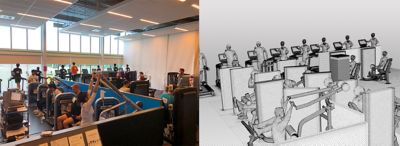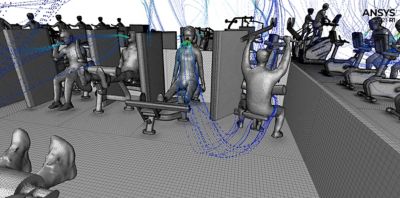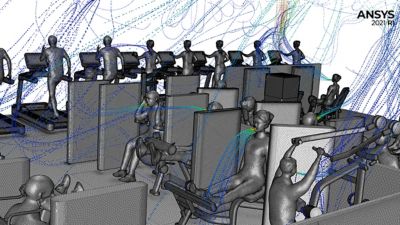-
United States -
United Kingdom -
India -
France -
Deutschland -
Italia -
日本 -
대한민국 -
中国 -
台灣
-
-
产品组合
查看所有产品Ansys致力于通过向学生提供免费的仿真工程软件来助力他们获得成功。
-
ANSYS ADVANTAGE MAGAZINE
July 2021
Breathe Easy: Conquering the Coronavirus with CFD
By Ansys Advantage Staff
Fitness centers equipped with insufficient ventilation have been identified by governments around the world as key hotspots for infection during the COVID-19 pandemic. Strenuous exercise causes gym patrons to constantly exhale large amounts of saliva droplets, which creates a particle concentration that is potentially loaded with the virus. As the concentration builds throughout the facility, it creates a substantial risk for those who may ingest virus particles, leading to infection. How can gym owners better protect their patrons? Many governments have delayed the reopening of fitness centers until this question is answered.
Recently, Sportinnovator in the Netherlands, appointed by the Ministry of Health, Welfare and Sport, took the lead on this critical issue, commissioning Dr. Bert Blocken and his Eindhoven University of Technology research team to examine whether ventilation and air cleaning systems could sufficiently reduce the buildup and inhalation of dangerous microscopic aerosol droplet particle concentrations. When aerosol particles are exhaled, they typically evaporate in a fraction of a second to a few seconds, leaving behind a solid nucleus particle, which the virus can reside on and could remain airborne for several hours, especially for smaller aerosol particles. Invisible to the naked eye, these particles could only be tracked using state-of-the-art computational fluid dynamics (CFD) simulation technology.
Ansys Fluent was used to digitally recreate the Eindhoven University of Technology sports center.
Blocken’s team set its sights on learning how to keep aerosol concentrations low enough so that the dose would not grow large enough to cause infection. By combining physical experimentation measurement and Ansys Fluent modeling, the team delivered a comprehensive answer for solving the issue, which would better educate the Dutch government and provide sufficient evidence to the public that properly equipped fitness centers could safely reopen during the pandemic.
The team used Fluent to track the number of particles within the confined space of a Dutch fitness center and learned that the ventilation system, even though it was 4.5 times stronger than the required minimum ventilation rate in the Dutch Building Code, was incapable of preventing the monotonic rise of particle concentrations in the air. This inspired them to find an effective, affordable and energy-efficient solution — advanced air purifying machines — that could work in tandem with the ventilation system, ingesting the particles to potentially rid the area of contagion and keep patrons safe.
Dr. Blocken’s team used Fluent to assess the fitness center’s airflow and understand how air purifiers and ventilation systems could join forces to help reduce contagion.
Gathering the Measurement Data
On July 11, 2020, Blocken’s team performed experimental analysis to measure the overall aerosol concentration average of the university sports center at Eindhoven University of Technology.
During the first part of the experiment, athletes rode stationary bicycles, exhaling into a machine that counted the number of different-sized aerosols. In the second part, Blocken’s team installed 147 sensors throughout the fitness center that gathered measurement data on 35 people exercising in a series of time slots of 30 minutes, assessing how many droplets patrons exhaled into the air while exercising at different intensities.
Next, the team leveraged the ventilation system and patrons’ mouths as boundary conditions and used a light scanner to quickly scan the body geometries of the athletes as they exercised on treadmills and other machines.
The experiments enabled the team to measure the invisible particle droplets and provided the critical data for creating the Fluent simulations, which digitally recreated the fitness center, delivered insights on the fitness center’s ventilation effectiveness and the effectiveness of the air cleaners, and illustrated how the particles traveled throughout the space.
Analyzing The Results
With Fluent and Ansys Cloud, the team discovered that the ventilation system and air cleaners could potentially each introduce oppositely moving indoor airflows that would, to a large degree, cancel each other out, limiting each other’s effectiveness. This means that the airflow produced by the ventilation system and the air cleaners must be carefully synchronized to achieve optimum results.
The team’s research also concluded that if a fitness center is equipped with a mechanical ventilation system that satisfies the legal minimum requirements but faces aerosol concentrations that are too high, the ventilation system does not need to be updated, which would involve a high cost. By optimizing the number and placement of air purifiers throughout the facility, the aerosol concentration can be effectively reduced — to as much as 90%–95% — delivering the most economical and most efficient means for reducing risk of airborne COVID infection, the flu or any other infectious diseases that might be present.
The team discovered that the ventilation system and air purifiers could work against each other if not synchronized.
Without Fluent, the team’s workload to complete all gym scenarios would have tremendously increased, stretching the very time-consuming aerosol particle measurement process with volunteer participants tested against COVID-19 to an estimated three years. Using Fluent and the compute power of Ansys Cloud via Microsoft Azure, the team accomplished their CFD research in just three weeks.
Blocken’s fitness center study results will help provide governments the proper advice for managing aerosol concentrations — not just in gyms but in countless other applications, spanning global venues such as schools, airplanes, elevators, business offices, movie theaters and more.
Following their success at the Eindhoven University of Technology fitness center, Blocken’s team is using Fluent to test upscaled versions of the air cleaning machines’ usefulness for large stadiums, such as Holland’s Johan Cruyff ArenA, the largest stadium in the country, and the Maaspoort, home of the most successful basketball team in the Netherlands. Deployment of these machines could soon improve public safety at large sporting events around the world.
现在就开始行动吧!
如果您面临工程方面的挑战,我们的团队将随时为您提供帮助。我们拥有丰富的经验并秉持创新承诺,期待与您联系。让我们携手合作,将您的工程挑战转化为价值增长和成功的机遇。欢迎立即联系我们进行交流。













